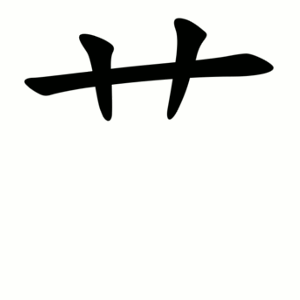艹
- the top radical form of 艸;
Usage in Korean
When used as a radical, it generally relates to plants, but it does not form derived characters related to trees because the 木 (tree) radical covers that domain.
When positioned at the top of a character, 艹 transforms into its abbreviated form.
In Korea, the two horizontal strokes of 艹 are counted as two separate strokes, while in Japan and China they are counted as one.
However, when writing by hand, Koreans sometimes write these two strokes as one, and visually the difference is often indistinguishable.
Some characters, such as 芻 (meaning "fodder"), display the two horizontal strokes arranged parallel vertically (one on top of the other).
According to Korean naming hanja standards, both writing styles — with the two horizontal strokes separated (2 strokes, total 4 strokes) or connected (1 stroke, total 3 strokes) — are recognized as equivalent and interchangeable.
This radical is commonly used in female given names.
- 十十 (JJ)
- 難十十 (XJJ)
- ⿻ 十 丨 (G J)
- ⿻ 丨 十 (G J)
- ⿰⿻ 乀 一 𠂇 (H T)
- ⿰ 十 十 (K)
